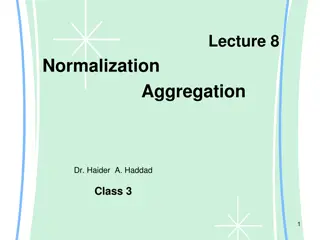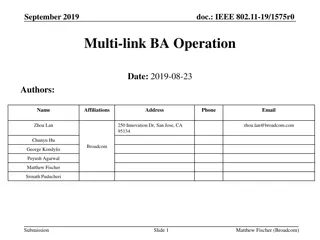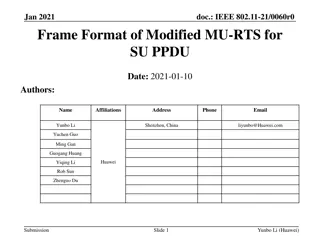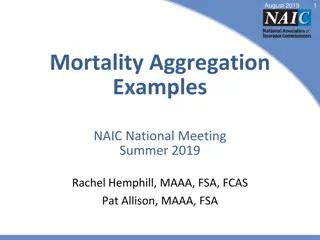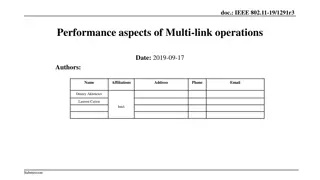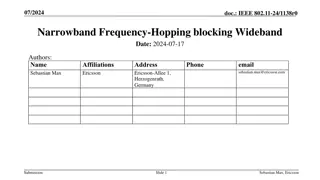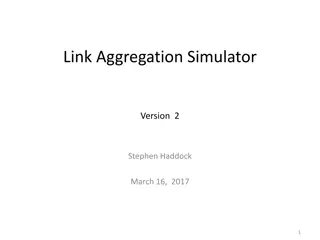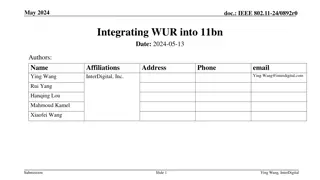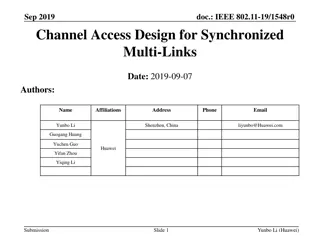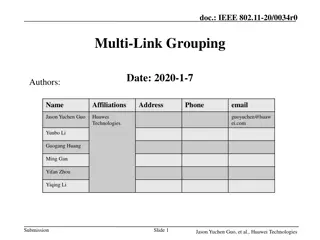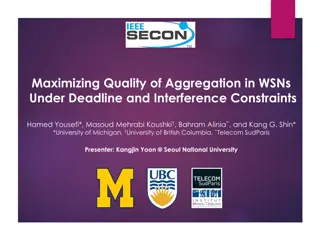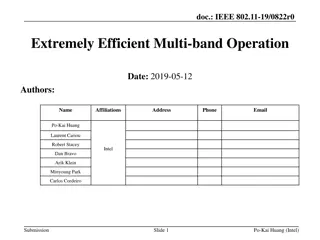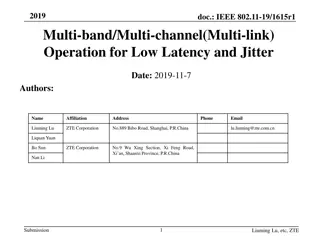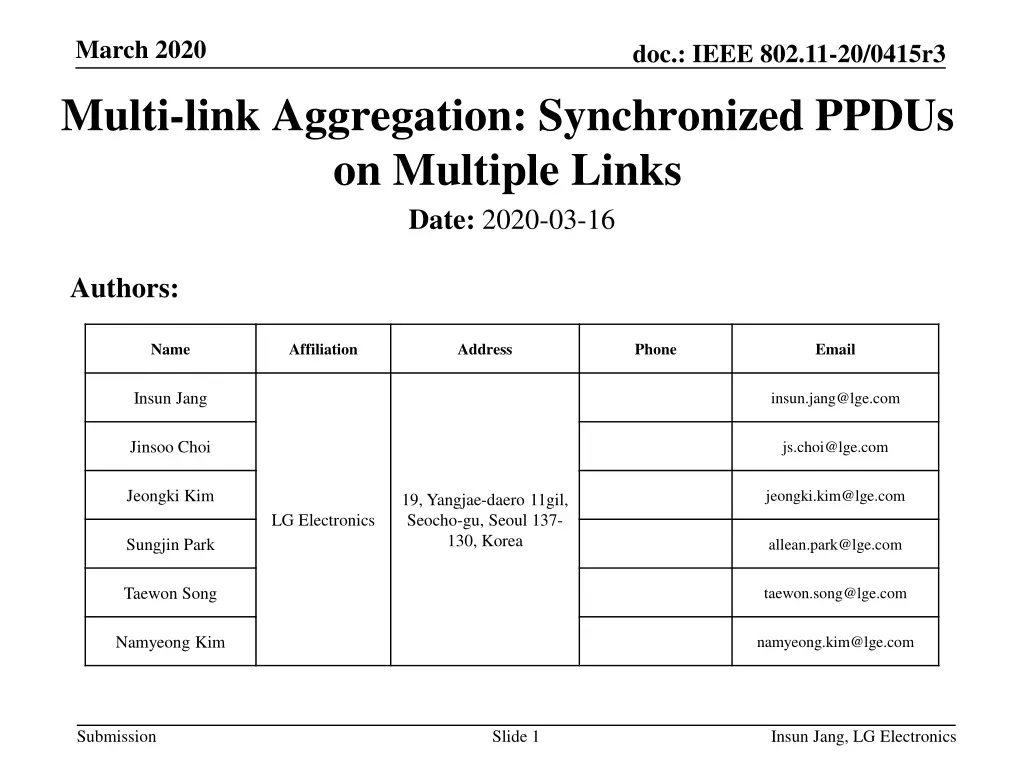
Synchronized PPDUs on Multiple Links: Improving MLD Throughput
Explore the concept of multi-link aggregation for synchronized PPDUs on multiple links in IEEE 802.11-20 standard. Understand the benefits for non-STR and STR scenarios, and how to aggregate on non-AP MLD side effectively. Discover solutions to enhance per-MDL throughput and decrease latency in wireless communication.
Download Presentation

Please find below an Image/Link to download the presentation.
The content on the website is provided AS IS for your information and personal use only. It may not be sold, licensed, or shared on other websites without obtaining consent from the author. If you encounter any issues during the download, it is possible that the publisher has removed the file from their server.
You are allowed to download the files provided on this website for personal or commercial use, subject to the condition that they are used lawfully. All files are the property of their respective owners.
The content on the website is provided AS IS for your information and personal use only. It may not be sold, licensed, or shared on other websites without obtaining consent from the author.
E N D
Presentation Transcript
March 2020 doc.: IEEE 802.11-20/0415r3 Multi-link Aggregation: Synchronized PPDUs on Multiple Links Date: 2020-03-16 Authors: Name Affiliation Address Phone Email Insun Jang insun.jang@lge.com Jinsoo Choi js.choi@lge.com Jeongki Kim jeongki.kim@lge.com 19, Yangjae-daero 11gil, Seocho-gu, Seoul 137- 130, Korea LG Electronics Sungjin Park allean.park@lge.com Taewon Song taewon.song@lge.com Namyeong Kim namyeong.kim@lge.com Submission Slide 1 Insun Jang, LG Electronics
March 2020 doc.: IEEE 802.11-20/0415r3 Introduction Some contributions have addressed the concept of multi-link aggregation [1]-[8], i.e., Transmission of Synchronized PPDUs on multiple links In this contribution, we discuss why and how non-AP MLDs should transmit synchronized PPDUs and announce relevant capability Especially, the capability is generalized to the sharing capability within MLD Submission Slide 2 Insun Jang, LG Electronics
March 2020 doc.: IEEE 802.11-20/0415r3 Overview of Multi-link Aggregation Multi-link Aggregation is a way to increase per-MLD throughput as well as decrease per-MLD latency as the most important requirements in 11be Basically, we can observe the aggregation in case of simultaneous TX/RX (STR) and non-STR STR means that to transmit and receive simultaneously is allowed on multiple links Non-STR means STR is restricted due to several reasons (e.g., power leakage) Synchronized PPDUs Submission Slide 3 Insun Jang, LG Electronics
March 2020 doc.: IEEE 802.11-20/0415r3 Why Synchronized PPDUs? Synchronized PPDUs can be a solution to increase per MLD throughput, especially in case of non-STR It also can resolve issues of non-STR on some level Even for STR, it may be good by mitigating the randomness of back-off Submission Slide 4 Insun Jang, LG Electronics
March 2020 doc.: IEEE 802.11-20/0415r3 How to Aggregate on Non-AP MLD Side Considering independent EDCA on each link After obtaining a TXOP on a link, what does happen on the other link(s)? We have several issues, ED-based CCA on link 2 is proper? On link 2, other transmissions (e.g., OBSS) as well as self-interference EDCA wouldn t be meaningful, eventually indicating always like BUSY channel Can STA 2 know self-interference channel/power level? If so, it already may be STR It is hard to distinguish between the self-interference and other signals Consequently, STA 2 just suspends EDCA (including CCA) Submission Slide 5 Insun Jang, LG Electronics
March 2020 How to Aggregate on Non-AP MLD Side (Cont d) doc.: IEEE 802.11-20/0415r3 Some contributions [1]-[7] already have proposed how to transmit synchronized PPDUs quickly on multiple links Mainly, on non-AP MLD side, xIFS-based Aggregation (e.g., PIFS) It is motivated by wide channel access [9] in legacy system; therefore, it can transmit synchronized PPDUs quickly to increase throughput The PPDUs may have a certain margin for starting/ending times [8] However, we need to consider several issues, i.e., An STA (STA 1) needs to trigger the transmission of other STAs (STA 2) in the same MLD tightly/quickly It ignores BCs (STA 2) for other links (link 2), which may impact on single-link STAs operating on the links (link 2) Submission Slide 6 Insun Jang, LG Electronics
March 2020 doc.: IEEE 802.11-20/0415r3 Aggregation Capability Announcement If an STA of an MLD can trigger the transmission of other STAs in the MLD immediately after the STA obtains a TXOP, we consider it as the STA capable of Immediate Aggregation (IA) MLD with IA Capa. can be helpful to MLDs incapable of IA For example, a non-AP MLD incapable of IA can request AP MLD IA [4] Non-AP MLD needs to know if AP MLD has IA capability Therefore, we propose an MLD can announce whether it is capable immediate aggregation Submission Slide 7 Insun Jang, LG Electronics
March 2020 doc.: IEEE 802.11-20/0415r3 Generalizing IA Capability First of all, IA capability is the capability based on whether STAs of an MLD can share PHY/MAC status (e.g., TXOP/PPDU length) with each other Some other operations already agreed/to be agreed also need the information sharing between STAs of MLD (e.g., acknowledgement of other link(s), PPDU end alignment) Consequently, as a high-level concept, the sharing capability needs to be announced and then negotiated in order to use the operations correctly Therefore, we propose an MLD can announce whether STAs of an MLD can share TBD information with each other Submission Slide 8 Insun Jang, LG Electronics
March 2020 doc.: IEEE 802.11-20/0415r3 How to Support Immediate Aggregation We discuss methods to mitigate the impact of aggregation Before and After aggregation Before Aggregation, We may restrict the aggregation For example, MLDs can negotiate the maximum number or a set of links to be aggregated, during setup or in the beginning of TXOP, or decrease a TXOP limit After Aggregation We may adjust the remaining BC or current CW For example, maintaining BC/CW [2] regardless of successful transmission In the end, IA could be applied under TBD restricted condition Submission Slide 9 Insun Jang, LG Electronics
March 2020 doc.: IEEE 802.11-20/0415r3 Summary In this contribution, we discussed why and how non-AP MLDs should transmit synchronized PPDU and announce relevant capability Synchronized PPDUs can be a solution to increase per MLD throughput, especially in case of non-STR To transmit synchronized PPDUs, we can use xIFS-based Aggregation (similar to wide channel access) We need to consider several issues, i.e., Announcement of Immediate aggregation (IA) capability How to mitigate the impact on single-link STAs We also generalized about the IA capability, i.e., sharing capability Whether STAs of an MLD can share the information (e.g., PHY/MAC status) with each other Submission Slide 10 Insun Jang, LG Electronics
March 2020 doc.: IEEE 802.11-20/0415r3 SP #1 Do you agree that 11be shall allow the following multi- link operation? When at least one STA of non-AP MLD with constraints transmits a PPDU, the other STA(s) defers (defer) the channel access without performing CCA during the transmission of PPDU Y/N/A Submission Slide 11 Insun Jang, LG Electronics
March 2020 doc.: IEEE 802.11-20/0415r3 SP #2 Do you agree that an MLD can inform a peer MLD of the capability of whether STAs of the MLD can exchange the information? Y/N/A Submission Slide 12 Insun Jang, LG Electronics
March 2020 doc.: IEEE 802.11-20/0415r3 SP #3 Do you agree that 11be shall allow the following multi- link operation? When an STA of an MLD obtains a TXOP, it triggers the transmission of other STA(s) of the MLD based on CCA during an interval of xIFS (e.g., PIFS) immediately preceding the start of the TXOP Condition of applying the operation is TBD Y/N/A Submission Slide 13 Insun Jang, LG Electronics
March 2020 doc.: IEEE 802.11-20/0415r3 SP #4 Do you agree that an MLD can announce the following capability? When an STA of an MLD obtains a TXOP, it can trigger the transmission of other STA(s) of the MLD based on CCA during an interval of xIFS (e.g., PIFS) immediately preceding the start of the TXOP Y/N/A Submission Slide 14 Insun Jang, LG Electronics
March 2020 doc.: IEEE 802.11-20/0415r3 References [1] 802.11-19/1144r6 Channel Access for Multi-link Operation [2] 802.11-19/1505r2 Multi-link TXOP Aggregation Considerations [3] 802.11-19/1927r1 Multi-Link Operation Simulation Methodology [4] 802.11-20/0026r0 MLO: Sync PPDUs [5] 802.11-20/0081r1 MLO-Synch-Transmission [6] 802.11-20/0291r0 MLO Asynchronize and synchronize operation discussions [7] 802.11-20/0487r0 Multiple Link Operation Follow Up [8] 802.11-19/1305r0 Synchronous Multi-Link Transmission [9] IEEE P802.11REVmd/D3.0 Submission Slide 15 Insun Jang, LG Electronics

